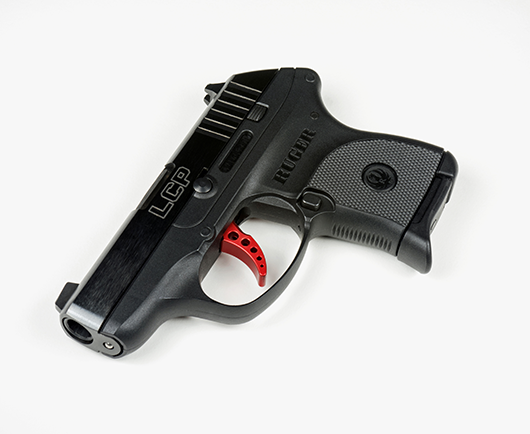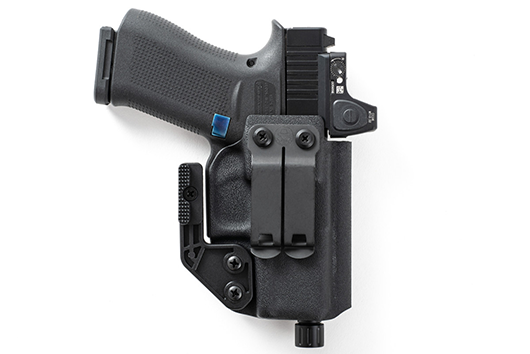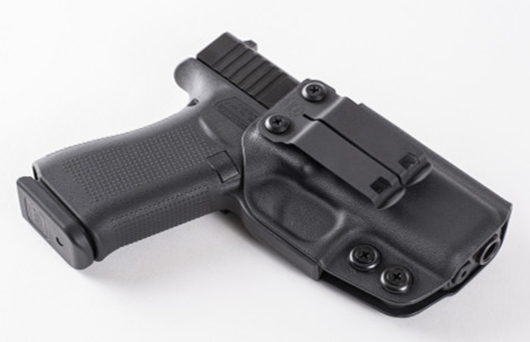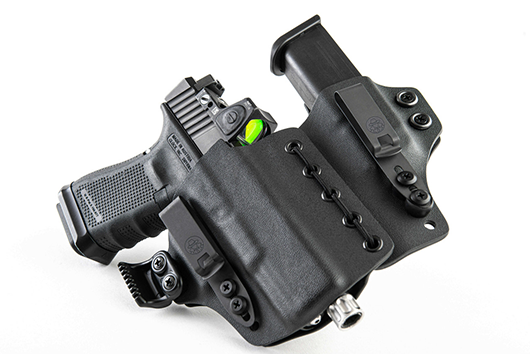How to Wear an Inside-the-Waistband Holster
Mar 24th 2021

There are a variety of ways to carry your firearm. Some gun owners choose to carry a firearm openly. Maintaining control of your gun should someone engage you in close-quarter combat is a concern and often requires a separate active-retention device such as a strap that snaps securely over the gun frame, which can interfere in quick weapon deployment.
Concealed carry allows you to retain the element of surprise. It also allows you to avoid spooking those unfamiliar with, or hostile toward, private citizens carrying weapons.
Two of the most popular methods are outside the waistband (OWB) and inside the waistband (IWB).
Where to Start
Once you’ve decided to carry a concealed firearm, you should determine where you want to carry it. In waistband carry, clock positions are used to denote gun placement. For example, 12 o’clock corresponds to your belt buckle and 6 o’clock to the small of your back. The two most popular waistband positions are:
Strong-side Carry: 3 o’clock or 9 o’clock
In this position, you wear the holster on or behind your right hip if you’re right-handed and left hip if you’re a southpaw. Strong simply means dominant or firing in this context. This is opposed to the weak or support side, which corresponds to your non-dominant hand.
Using the clock-face metaphor, the strong side is 3 o’clock (right side) or 9 o’clock (left side). Strong-side carry strikes a good balance between speed and access. Your dominant hand falls naturally by your side.
Appendix Carry
When you use appendix carry, the gun sits at the 12 or 1 o’clock position by your navel or center torso, right behind your belt buckle.
Appendix carry permits a very fast draw and stains your shoulder less when pulling the gun out.
If you are overweight or your body type emphasizes your waistline, appendix carry may not conceal your gun well.
Appendix carry also requires careful attention to safety when drawing and reholstering.
Try Several Positions
Finding the most comfortable position that suits your specific needs means you should try several carry positions before settling on one.
Wear your gun on your strong side, in the appendix position, and anywhere else that you think may be suitable. Wear your gun while walking, driving, seated behind a desk. Try it while moving in a variety of directions. If your gun is uncomfortable to carry, you may leave it on the nightstand or in a safe.
Clothing Size
As an IWB holster requires that the gun holster fit between your waistband and body, you’ll have to be aware of how your clothing fits. If your pants are tight or form-fitting, it’s commonly suggested that you should buy a pair the next size up to accommodate the holster. If you wear loose-fitting pants, the gun holster may fit without the need for a change of size. You’ll have to experiment to see which system works best for you.
While IWB carry can work with a full-size service pistol, you’ll probably find compact and subcompact handguns more comfortable to carry.
You may be tempted to wear tactical or BDU pants. These provide durability at the expense of discretion.
Concealment

The IWB design allows you to conceal a firearm deeply. Many gun owners simply drape a t-shirt or collared shirt over the gun holster. When you practice your draw stroke, you should always draw from concealment. You need to practice lifting or sweeping away clothing to acquire a full firing grip on your weapon.
As part of concealment, you also need to consider the type of firearm you intend to carry and how it fits. A full-size service pistol or revolver prints more than a compact or subcompact handgun with a shorter grip.
The quintessential concealed-carry handgun used to be the snub-nosed revolver in .38 Special. While that kind of weapon is still popular among those who carry concealed firearms, subcompact and micro-compact semi-automatic pistols are gaining a foothold.
Full-Size Concealment
If you choose to carry a full-size handgun to conceal carry, selecting a holster that allows you to adjust the cant helps keep the gun out of sight. A forward cant lifts the grip and can significantly reduce printing.
Using a full-size gun, you can also increase your holster’s concealability by trying different belt clips and concealment devices, depending on the model weapon you use.
Gun Belt
Whether you carry in an IWB or OWB holster, you need a suitable gun belt for carrying inside the waistband. A dedicated gun belt is more durable and rigid than those designed for dress or casual wear.
However, the holster and gun belt must complement each other. The gun belt needs to support the holster and pistol’s weight together, and the holster needs to distribute the weight evenly. A good belt ensures that your gun doesn’t sag or cant outward from your waistband, which can exacerbate printing and cause discomfort.
Final Thoughts
At Incognito Concealment, we understand the importance of discretion when carrying a firearm. We offer several holster designs — IWB and OWB — to suit various carry methods, positions, and firearms. If you’d like us to help you find the perfect holster, give us a call at (586) 999-5820.











